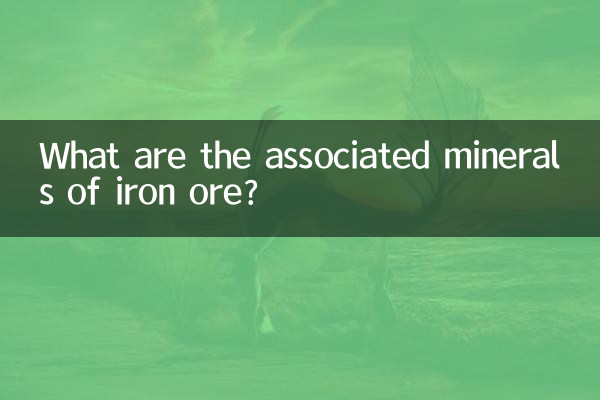What are the associated minerals of iron ore?
Iron ore is one of the most common metal minerals on earth and is widely used in the steel industry. However, iron ore does not exist independently and usually grows symbiotically with other minerals to form associated ores. These associated minerals not only have economic value, but may also affect the mining and processing of iron ore. This article will discuss the main associated minerals and their characteristics of iron ore, and attach structured data for reference.
1. Common associated minerals of iron ore

There are many types of associated minerals in iron ores, mainly depending on the type of deposit and geological conditions. The following are several common iron ore associated minerals:
| Associated mine name | chemical formula | Main purpose | economic value |
|---|---|---|---|
| Ilmenite | FeTiO3 | Titanium metal extraction, coatings, aerospace | high |
| Pyrrhotite | Fe1-xS | Sulfur production, nickel and cobalt associated production | Middle to high |
| cuprite | Cu2O | Copper metal extraction, electronics industry | high |
| rhodochrosite | MnCO3 | Manganese metal extraction, battery manufacturing | in |
| apatite | Ca5(PO4)3(F,Cl,OH) | Fertilizer production, chemical raw materials | in |
2. Mining and utilization of associated minerals
The mining and utilization of associated ores are crucial to the economic benefits and environmental impact of iron ore. The following are several methods of mining and utilization of associated minerals:
| Associated mines | Mining method | Processing method | environmental impact |
|---|---|---|---|
| Ilmenite | Open pit or underground mining | Magnetic separation, flotation | Medium, tailings need to be processed |
| Pyrrhotite | Mainly underground mining | Roasting, pickling | High, easy to produce sulfur dioxide |
| cuprite | Open pit or underground mining | flotation, smelting | High, heavy metals need to be processed |
| rhodochrosite | open pit mining | Roasting, electrolysis | Medium, requires wastewater treatment |
| Apatite | open pit mining | Acid decomposition | High, easily causing eutrophication of water bodies |
3. Economic value and market prospects of associated mines
The economic value of associated minerals varies depending on their use and market demand. The following are the market price trends of some associated mines in recent years:
| Associated mines | Price in 2022 (USD/ton) | Price in 2023 (USD/ton) | growth rate |
|---|---|---|---|
| Ilmenite | 350 | 420 | 20% |
| Pyrrhotite (sulfur content) | 180 | 200 | 11% |
| Cuprite (copper content) | 8,500 | 9,200 | 8% |
| Rhodochrosite (manganese content) | 1,200 | 1,350 | 12.5% |
| Apatite (phosphorus content) | 250 | 280 | 12% |
4. The future development direction of iron ore associated mines
With the advancement of technology and the improvement of environmental protection requirements, the mining and utilization of iron ore associated minerals are developing in an efficient and green direction. The following are several possible future development directions:
1.Comprehensive utilization of technology: By improving the mineral processing process, the recovery rate of associated minerals is increased and resource waste is reduced.
2.Environmentally friendly mining: Adopt low-pollution mining and processing technologies to reduce negative impact on the environment.
3.High value-added product development: Processing associated ores into high value-added products, such as titanium alloys, lithium battery materials, etc.
4.Intelligent Mining: Use big data and artificial intelligence to optimize the mining process and improve efficiency and safety.
In short, the associated ores of iron ore not only enrich the mineral resources, but also provide important raw materials for related industries. In the future, through technological innovation and green development, the economic value and environmental benefits of these associated mines will be further enhanced.

check the details

check the details